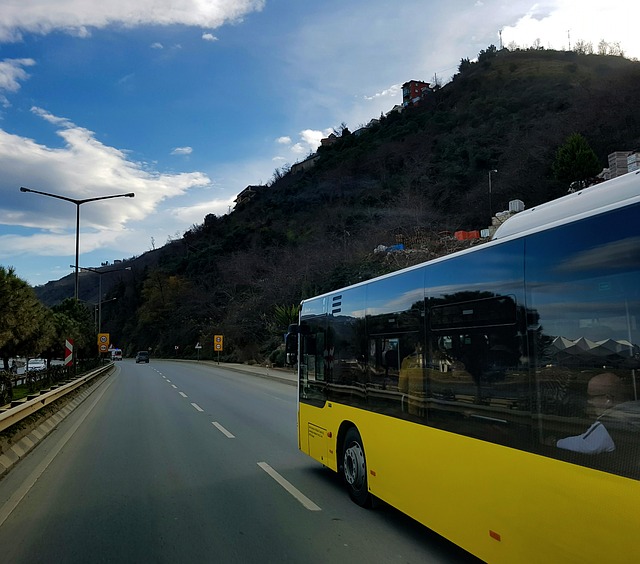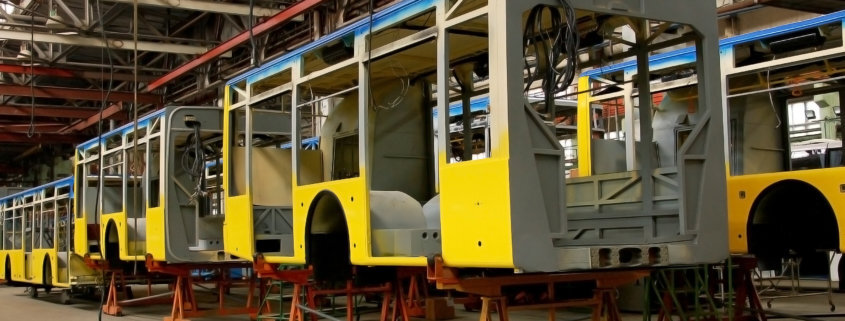Adhesives and sealants for buses
Adhesives and sealants for buses replace fasteners
The bus manufacturing industry is currently shifting away from mechanical fasteners and replacing them by adhesives and sealants for buses. The shift towards adhesives and sealants in bus assembly processes is encouraged by the need for increased sustainability, use of composite materials, aerodynamic designs and safety regulations. Buses consume annually some 4.5 million liters (1.2 million gallons) of adhesive alone. The consumption of sealants is also rather high, and ever-increasing. Adhesives and sealants are used for example in bus roof sealing and bonding, floor sealing, as direct glazing adhesive systems as well as in interior panel and trim bonding.
Here you will find everything you need to know about adhesives and sealants used in different stages of bus manufacturing.
Stronger, lighter safer & faster buses with adhesives and sealants
Adhesives and sealants for buses are designed to meet the requirements of making the process and products stronger, safer, faster and lighter.
- Stronger: adhesives and sealants increase the durability of buses as they prevent corrosion unlike mechanical fasteners which are prone to cause galvanic corrosion.
- Lighter: the use of adhesives and sealants instead of mechanical fasteners can lead to up to 80 kg weight reduction. Additionally, adhesives for buses make it possible to bond indifferent materials together without needing to worry about damaging either of the materials.
- Safer: some adhesives and sealants are designed to damp impact, which makes them improve the buses´ crash test performance. These systems are found especially in interior panel and trim bonding, and as direct glazing adhesive. Also fire retardant adhesives exist contributing to fire safety on board. The fire retardant adhesives used in buses have zero contribution to spreading flames.
- Faster: not only allow adhesives and sealants for more aerodynamic designs, but they are also faster to process, which reduces the production time of buses.
Bus adhesive and sealant applications from direct glazing to interior trim bonding
As chemical seals and bonds are taking over in the bus industry, the number of applications is continuously increasing. It is not only about making windows watertight with a glazing adhesive but also keeping the body structure together. The adhesive and sealant applications do not solely focus on the frame, interior trim bonding and exterior of the buses, but also contribute to the mechanisms under the hood including engine components and batteries. Below you will find the more specific applications of adhesives and sealants for buses.
Bus body structure bonding
During the assembly of bus body structures, several adhesives and sealants are used in order to prevent corrosion, water ingress and standing water. They also contribute to comfort during long bus rides.
Possible adhesive and sealant solutions
The bonds and seals in the body structure of buses can be realized by various products depending on the application. There are easy to process, one component sealants such as MS polymers which are often green options, as they do not contain harmful isocyanates nor solvents, and their VOC (volatile organic compound) value is close to zero or zero. The growing demand for MS polymers is based on the need for environmentally friendly products. Discover the possibilities of the best MS polymer systems.
Next to MS polymers, the adhesives for body structures are often hybrids of polyurethane and epoxy, and they cure by adding heat.
Benefits of using adhesives and sealants
- Smooth surface appearance and less rework
- Increased comfort due to dampening sound and vibration
- Bonding dissimilar materials increasing design freedom
- Reduced risk of corrosion
Interior trim bonding
The development of interior design of buses has led to the use of ever-growing mix of plastics and fabrics which require durable and environmentally friendly bonding solutions. Therefore, it is important that adhesives for bus interior trim bonding improve appearance and contribute to comfort.

Possible adhesive and sealant solutions
Standards set for bus interior panel and trim bonding encourage the manufacturers to choose for green solutions with as little environmental impact as possible. Therefore, the most common adhesive for bus interiors is hot melt which appears in a solid phase in room temperature, and softens when heated. These adhesives allow for extremely fast processing.
Benefits of using adhesives and sealants
- Environmentally friendly bonding solutions
- Improved appearance, no visible fixings
- Fast production process due to application benefits
Bus floor sealing, side panels, luggage doors and hatches
Bus operators expect outstanding durability from their vehicle regardless of driving conditions. Therefore, the bus must be safe in possible crash situations and it should not degrade due to harsh climatic conditions.
Possible adhesive and sealant solutions

For sealing floors, side panels, luggage doors and hatches MS polymers are a common choice as they form watertight seals which are resistant to a wide variety of chemicals. However, the bonding of these applications is often realized with elastic polyurethane adhesives which cure fast and exist as one and two component systems. Also MMA adhesives are common especially in bonding interior panels. Similar solutions are applicable to train interiors.
Benefits of using adhesives and sealants
- Increased impact safety in the event of a crash
- Improved comfort due to damping sounds and vibration
- Better looks as there are no visible fixings
- Resistance against extreme temperature conditions
Bus roof sealing and bonding
The roof is one of the most important parts of a bus, and the design still is one of the greatest challenges for bus manufacturers. Even though adhesives and sealants give more design freedom and ease the challenge, factors such as high temperature development, thermal expansion coefficients and structural integrity must be taken into account when choosing the bonding and sealing materials.
Note that similar systems are also suitable for gluing antennas and receivers on bus roofs.
Possible adhesive and sealant solutions
Bus roof sealing and bonding require flexible solutions. Therefore, they must not be sensitive to whatever the environment might throw at the roof. The bus roof sealant and adhesive systems are often polyurethane based or hybrid systems. They exist as one and 2 component systems which allow for fast curing, speeding up the production process.
Benefits of using adhesives and sealants
- Longevity and durability
- Improved corrosion resistance
- Improved body stability and reduced fuel consumption due to lighter weight
- Reduced weight due to the elimination of mechanical fasteners
- Dampening sound and vibration
Benefits of using adhesives and sealants
- Increased impact safety in the event of a crash
- Improved comfort due to damping sounds and vibration
- Better looks as there are no visible fixings
- Resistance against xtreme temperature conditions
Front and rear mask adhesives and sealants
The front and rear masks contribute to the aerodynamic design of buses. The use of adhesives and sealants instead of mechanical fasteners allows for more aerodynamic shapes and so contributes to reduced fuel consumption.
Possible adhesive and sealant solutions
Adhesives and sealants for front and rear masks of buses are usually thermoplastics which can be shaped when not completely cured. The solutions include polyurethane and hybrid systems which cure fast allowing for shorter processing times. These adhesive and sealant systems are usually one component solutions, which also makes the processing less laborious.
Benefits of using adhesives and sealants
- Design freedom due to thermoplastics
- Reduced weight due to elimination of mechanical fasteners
- Protection against water and moisture ingress
- Improved body stability and reduced fuel consumption
Bus direct glazing adhesive and sealant solutions
Glazing adhesives and joint sealants are the oldest chemical sealing and bonding products used in bus assembly lines. They are suitable for sealing and bonding direct glazing application as they provide fast curing times and high initial strength as well as contribute to aerodynamic design and stability of the vehicle. As the glazing of buses involves large and heavy surfaces, the adhesive must be chosen carefully opting for the highest quality. In some cases the direct glazing adhesive require sealing using an appropriate sealant system. Gain more information on the best glazing adhesives and sealants!
Possible adhesive and sealant solutions

The range of adhesives and joint sealants for direct glazing of buses is broad, and the product should be chosen based on the production process and desired application method. The possible products included MS polymers, silicone sealants and polyurethane based adhesives.
Benefits of using adhesives and sealants
- Simplification of production processes
- Cost reduction
- Shorter processing time due to fast curing products
- Automated application is possible
- Protection against water and moisture ingress
- Improved aerodynamics
Improve efficiency and choose the right products for buses
Choosing the right adhesives and sealants for buses is crucial due to the fact that they contribute to the overall durability, safety, weight and comfort of the vehicle. A wrong choice, however, can make buses degrade faster. Therefore, one should always consider consulting an adhesives and sealants expert before making the final choice.
We at adhesives+coatings are dedicated to help you find the right adhesives and sealants for buses you manufacture. Feel free to contact us for more information about the best solutions, consultancy and finding the solutions your buses need!



